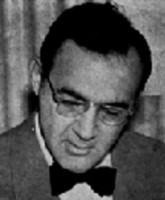BENNY GOODMAN
and
Reginald Kell

On tour with a British Big Band
Lionel Hampton
Teddy Wilson
Reginald Kell delivered a lecture on the principles of clarinet playing recently under the auspices of Boosey & Hawkes which, apart from its intrinsic interest, threw some light on to Benny Goodman, the man behind the public mask. Leslie Evans was there to report.
Kell, Principal Clarinet with the Liverpool Philharmonic, Royal Philharmonic and Philharmonia orchestras and the only British musician chosen by Toscanini to play with the Lucerne Festival orchestra has numbered among his pupils Benny Goodman, Peanuts Hucko and Jose Ferrer.
Benny Goodman changed his complete clarinet embouchure, and altered his fingering and tonguing methods after he had already been acclaimed all over the world as the finest jazz player on clarinet of the Swing era.
This astonishing information was disclosed by Reginald Kell, the brilliant international principal clarinettist and concert soloist, during his recent lecture at the Russell Hotel, London, organised by Messrs. Boosey and Hawkes.
Reginald Kell has lived in the USA since I948, and quite early on, Benny Goodman asked to take lessons from him. Kell realised, however, that any changes made would undoubtedly have a marked backward effect on BG for some time. He could imagine himself walking down the street with the great American Public pointing him out as "the man who ruined our Benny Goodman." Goodman, however, was insistent, and started his lessons in I952 studying under Kell until I959.
He realised his own weaknesses quite clearly: not a very good sound, a weak staccato, finger ing problems. He used the popular single lip embouchure up to that time (top teeth on the mouthpiece lower lip turned over the teeth), but insisted that he must change to the double–lip embouchure (both lips turned in over the teeth). Now so far as note and tone production were concerned, that meant going back almost to the beginning. Indeed, at first he was able to produce only the low notes. Above C (just about in the upper register), his notes faded away to nothing at all. Reginald Kell prescribed long notes played at a soft volume in the lower register and not rising beyond C to strengthen the new embouchure. Goodman was visiting him three times a week at this stage.
During one lesson he explained that he could not attend for another eight weeks, as he was going on tour. Kell advised the same practice routine for that period.
Some six weeks later, he was surprised to get a long distance call from BG who was in Los Angeles about 3, ooo miles away. He wanted to see Kell urgently next day, at 4 p.m. but declined to say why.
BG caught his plane, duly turned up for his appointment, took his clarinet out of the case and blew with very good control right up to top G (4 lines above the stave). He turned to Kell and asked anxiously: "How did that sound?" "Very good. It sounds fine to me " replied Kell. BG said: "That's what I thought, too." Then he packed his clarinet again, shook hands and planed another 3, 000 miles back to L. A.
In the early lesson stages, Goodman mentioned fingering problems, pointing out that on most of his solos on records he used a lot of low register, a lot of the upper register, but deliberately avoided playing across "the crack" (we call it 'the break'). Reginald Kell taught him to use the instrument more fully and improved his fingering technique in all registers.
If there is a moral to this, then it must be that a man of Goodman's stature, having achieved greatness in his own field, still realised his shortcomings and did something about it.